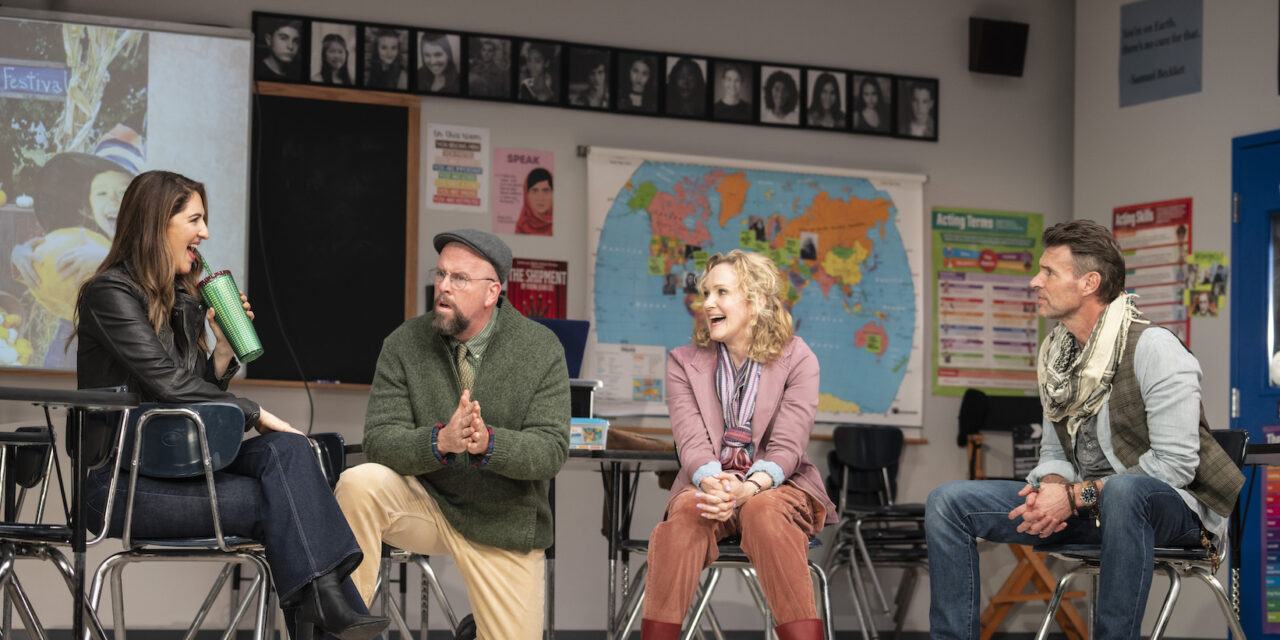By Stuart Miller . . .
Interspersed throughout Larissa Fasthorse’s Thanksgiving Play are short films with children recreating actual pageantry performances from around the country that celebrate our Thanksgiving heritage.
These snippets capture how warped our American mythology is and why a little bit of critical race theory might go a long way in our schools—in one, we see the children singing “Two little Indians foolin’ with a gun, One shot t’other and then there was one; One little Indian left all alone; He went out and hanged himself and then there were none.”
As the audience gasps and laughs nervously, the horror only increases when text appears on the screen reading, “Teacher’s comment: For fun, try having students sing ‘Injun’ instead of ‘Indian.’ My students loved it.”

Unfortunately, the play itself only fitfully matches the impact of these segments, often settling instead for satirizing of white liberals—which generates plenty of laughs, but sometimes feels sitcom-safe.
The play originated as a result of FastHorse’s growing frustration with producers saying her plays featuring Native American characters and issues were uncastable. So, she wrote a fast-paced comedy that tackles serious issues about racism and representation but with indigenous people completely absent from the stage.
FastHorse, a member of the Sicangu Lakota Nation, proved her point—this play, with only white actors, earned a successful off-Broadway run before the pandemic, became one of the most produced plays around the country, had a celebrity-streaming version (with Bobby Cannavale, Keanu Reeves, Heidi Schreck and Alia Shawkat) and . . . is now debuting on Broadway.
(Those filmed segments as well as references to life after George Floyd, are new to this production, which was snappily directed by Rachel Chavkin.)


However, even when the show is savagely funny, it is, to some extent, a victim of FastHorse’s strategy. The absence of Indigenous voices is a major issue for the characters in the play but it would have benefited from an Indigenous character to lend the play some heart and some heft.
The white characters are drawn so broadly and are such easy satirical targets that too much of the time it feels easy for the largely white audience to say, “Well, that’s not me. I’m not that ridiculous” and to laugh freely without feeling complicit.
The plot revolves around Logan (Katie Finneran), a drama teacher, as she strives to devise a politically correct Thanksgiving play for her school that will be pleasing to all yet still educationally powerful. She’s assisted by her boyfriend Jaxton (Scott Foley), who is as aggressively and eagerly woke as Logan and as delusional about his acting career as she is about hers as a director.
They bring in Caden (Chris Sullivan), a teacher who is somehow a big fan of Logan and Jaxton’s work, as their history consultant and volunteer co-star; also on hand is Alicia (D’Arcy Carden), a professional actress with a thin and misleading resume—she was hired with a grant to be used for a Native actor, but in reality Alicia is no such thing.


“My agent had me take headshots as six different ethnic people,” she explains. “My Native American shot has me in braids and a turquoise necklace.”
There are some brilliant scenes, like the one in which Jaxton and Caden, left to their own devices without the women, come up with a violent scene that produces the only appearances of any Native Americans—when their characters hold up the decapitated and bloody heads of those they have vanquished. They then treat the heads like a football.
Caden defends the inhumane behavior of the whites as being historically accurate, while Jaxton argues that “It’s like those programs in high school where they make you visit a prison to stay out of prisons and see a crashed car to stay out of drunk driver cars and visit a morgue to . . . stay out of morgues.”
Clearly, they have lost the narrative.
At its best, in scenes like that, or when Logan tries to create a play with the white actors speaking to Native Americans who aren’t there—as a representation of their erasure from America and American history—Thanksgiving Play offers a necessary and satisfying gut punch. Of course, it’s possible that if more of them landed the play would not have found such a wide audience on Broadway and around the country; so perhaps we should give thanks for the scenes that do.
Thanksgiving Play. Through June 4 at 2nd Stage’s Hayes Theater (240 West 44th Street, between Seventh and Eighth Avenues). www.2st.com
Photos: Joan Marcus


















